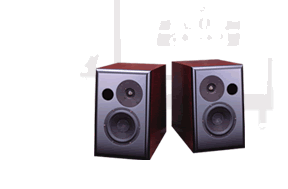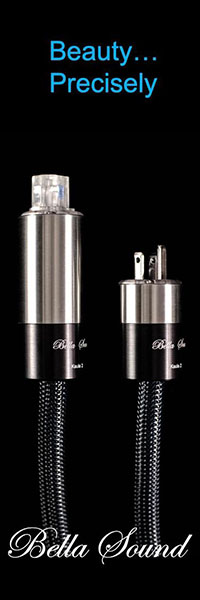The Musse Audio Reference Two NF Loudspeakers
| The Musse Audio Reference Two NF Loudspeakers |
|
Follow Up Report |
|
Henry Wilkenson |
|
15 March 2002 |
 Specifications
Specifications
Enclosure Type: Two way ported design
Tweeter: One 1″ soft dome
Woofer: One 6.5″ carbon Fiber woofer
Frequency Response: 35 Hz to 20 Hz +/- 3db
Sensitivity: 87db @ 1m/2.8 v
Impedance: 8 ohms
Rated Power requirement: 50 to 200 watts RMS
Port tuning frequency: 29 Hz
Equipped with 5 way binding posts
Price: $5,000.00 per pair
Address
Musse Audio Pte Ltd.
151 Chin Swee Road
#06-05/07 Manhattan House
Singapore 169876
Tel: 60-19-3139816
Fax: 60-3-31912340
Web: www.musseaudio.com
It has always been a rule of thumb that small, stand mounted speakers had special sonic virtues. These qualities centered around, but were not limited to, their ability float a large and convincing image. Speed and transparency throughout the midrange was another area where the smaller speakers were said to out perform their floor standing brethren. However, if you opted for the small speakers sonic abilities, you had to give up anything resembling a convincing low end. Many people felt that the “bottom” could be ignored since the majority of the music resided in the mid-range anyway.
While Perry and I live in adjoining states, fortunately public transportation is such that it is a relatively quick and easy trip for me to get over to his place. Recently, I was there after some major changes were made to his system. Unbeknownst to me, the new Talon Roc subwoofer was added to the system. The results left others in the room, as well as me, speechless (very tricky Perry). I thought that a major improvement had been made to his system with the addition of the new Talon Khorus X speakers. As good as the old Talons were, the X’s performance places them head and shoulders above them. However, the new sub takes the system to a much higher level of musicality. This is not a small incremental improvement; rather, it is a quantum improvement. Seldom have I been witness to this level of improvement being achieved in one step. It really has to be heard in order to be believed. You will be hearing much more about this sub as time goes on. The point here is simply this: the bass is very important to the overall musical spectrum.
Former ST contributor Tim Shea, in his thorough and insightful review of the Musse Two’s, commented upon the capabilities of the Musse Two’s in this area. The folks at Musse Audio have joined the ranks of a growing number of manufactures that have recognized the need and desirability of having a decent low end, even in small speakers.
As Tim stated in his review, the Musses are a beautifully finished, two-way monitor. However, given their large size, these speakers deserve to have dedicated stands that would offer better support and stability. The stands that are shown in the picture are the ones that I used and I found them to be inadequate for this speaker. The top plate is very small; as a result the speakers are capable of being easily knocked over.
My second complaint concerns the five way binding posts on the rear. The two pair of binding post is set a little too close together and the center post is too large for many spade lugs to fit over. This necessitates the need to use banana plugs; this is my least favorite way of connecting speaker wire. A set of dedicated jumpers should also be included for those people who wish to use a single run of speaker wire. While Cardas binding posts are available as an option, I feel that at this price level, they should be standard issue.
Those nits aside, these are fine speakers. I found their overall sonic perspective to be a little on the laid back side. That works just fine for me. Tonally I have to say that they are somewhat warm sounding. While the lateral imaging is good, the images across the stage were not quite as well defined as I heard from the Eggleston’s. They also didn’t quite match the Eggleston’s unique ability to resolve tonal information. While the Egglestons were not quite as warm overall as the Musses, they served up a richer tonal palate. For instance, the differences between Coltrane and Adderley on Miles Davis, Kind of Blue [Columbia Legacy CK 64935] was more clearly delineated with the Egglestons. The Reference Two’s didn’t quite match the Fontaines in treble extension or openness. I wouldn’t say that they were veiled, however, in direct comparison to the Fontaines you can readily hear the Egglestons have the edge in this area.
Where the Reference Twos really shine is when it comes time to rock. Their low-end extension provided more body and more foundation to the music. Curtis Lundy’s “Players Anthem,” from the Against All OddsCD [Just in Time Just 129-2], begins with a prominent bass intro that the Reference Twos handle exceptionally well. In this regard, you forget that you are listening to a stand-mounted monitor. If the lights were out, you could be fooled into thinking that you were listening to a floor stander. Etta James’ “Here I Am,” from her, Life, Love & The Blues [Private Music 01005-82162-2] was recorded with a very prominent bass guitar accompaniment that undulates throughout the song. While larger satellite and sub-woofer combinations perform far better with this piece, the Reference Twos still served the music very well. This is foot tapping dance music that a polite, base shy speaker just wouldn’t be able handle very well.
I feel that this speaker is better suited to jazz, pop and rock music. For Baroque or other classical works, the slight lack of transparency that I mentioned earlier would be problematic. The “Menuet pour la petit gnomide,” from Marc Antoine Charpentier, Divertissements Airs et Concerts, William Christie Les Arts Florissants, [Erato 25485] is a piece that once heard on a really transparent system will make a lasting impression. The limitation in treble extension and transparency of the Reference Twos become quite evident here. These problems were minimized while using the Audience speaker cables and interconnects. This combination produced a good even tonal balance while reaching the speaker’s limits of speed and transparency. I have to wonder if this might be the sonic price that is paid for the lack of a pair of dedicated stands.
I find the high number of speakers competing in the five thousand-dollar price range to be astonishing. While I will never consider anything in this price range to be a “bargain”, I do acknowledge that the speakers I have heard in this range do consistently offer superior performance levels over less expensive ones.
While sonic compromises have to be made with any speaker, regardless of price, the performance level of monitor speakers has risen considerably in the past few years. During my time with them, I found the Reference Twos very musical and easy to listen to for extended periods. At no time were they in any way hard or harsh sounding, nor were they trying to excel at only one or two sonic attributes. Rather they seemed to strive for a good musically balanced sound. In that, they were successful.
If the issues that I raised previously are addressed, I believe that the Musse Reference Twos will be competitive with anything in its price class.
Publisher’s comments:
I must concur with Henry’s finding of the Musse Reference NF monitors. They don’t provide the last nth of detail in the upper frequencies as other designs may. But I am adamant that it isn’t rolling off the treble either. Here’s my reason. My experience has shown that no matter the transducer, when the bass balance isn’t adequate, more times than not, the treble excels at a pace that gives the treble the appearance of possessing a halo. This is typical in high end audio. Worse, treble this disproportionate to the audio spectrum causes this listener to duck at every dynamic peak on a song. The Talon X is the first loudspeaker that taught me a new appreciation of what I’ve discerned as the proper tonal nourishmentall the way up the audio spectrum by virtue of its unequaled bass. The Reference 2’s do this nifty feat surprisingly well.
It is to this end, that I find it so fascinating that even the most skillful of audiophiles find Musse Audio Reference 2’s slightly rolled sounding. With a loudspeaker that can unfurl bass in all of its many shades and colors, (albeit in a slightly smaller picture than the bigger and costlier Rosinante’ Dulcineas and the Talon Khorus X), it would be easy to assume the top end isn’t as extended as certain competitors. Again, it is not rolled off. It’s no coincidence this very argument was made against the Dulcinea and Khorus X, especially since both do bass respectively among the best in their class. I will say that the Musse’s laid back personality and wonderful harmonic integrity will do more for the music lover than Joe audiophile looking for the loudspeaker of the month. Especially to the lover of the ’60’s, most dominate voices in jazz like Ella Fitzgerald, Billie Holiday, Sarah Vaughn and Betty Carter. For listening through the Musse’s with their exquisite upper bass speed and articulation, adds exactly what all the reissues have attempted to do: add warmth and resolution.
Lastly, because they play louder than many would think possible due to their diminutive stature, headbangers who love to crank but are cramped for space should all rejoice. This speaker doesn’t just go but it also goes low. The Musse Reference is a loudspeaker that simply sounds right to these ears and needn’t apologize for its non-aggressive, sultry performance. If musical enjoyment is your goal then you then this is one speaker you ought to audition.
![]()
Don’t forget to bookmark us! (CTRL-SHFT-D)
Stereo Times Masthead
Publisher/Founder
Clement Perry
Editor
Dave Thomas
Senior Editors
Frank Alles, Mike Girardi, Russell Lichter, Terry London, Moreno Mitchell, Paul Szabady, Bill Wells, Mike Wright, and Stephen Yan,
Current Contributors
David Abramson, Tim Barrall, Dave Allison, Ron Cook, Lewis Dardick, John Hoffman, Dan Secula, Don Shaulis, Greg Simmons, Eric Teh, Greg Voth, Richard Willie, Ed Van Winkle, Rob Dockery, Richard Doran, and Daveed Turek
Site Management Clement Perry
Ad Designer: Martin Perry





Be the first to comment on: The Musse Audio Reference Two NF Loudspeakers